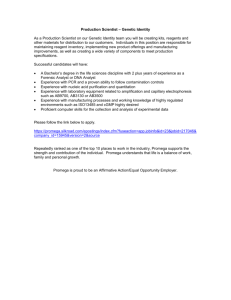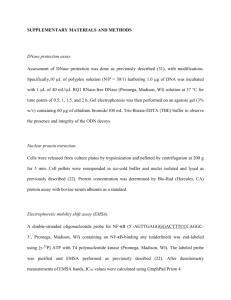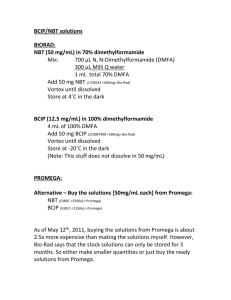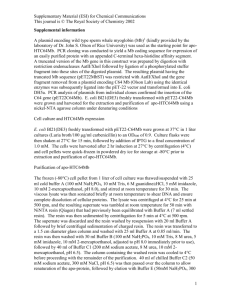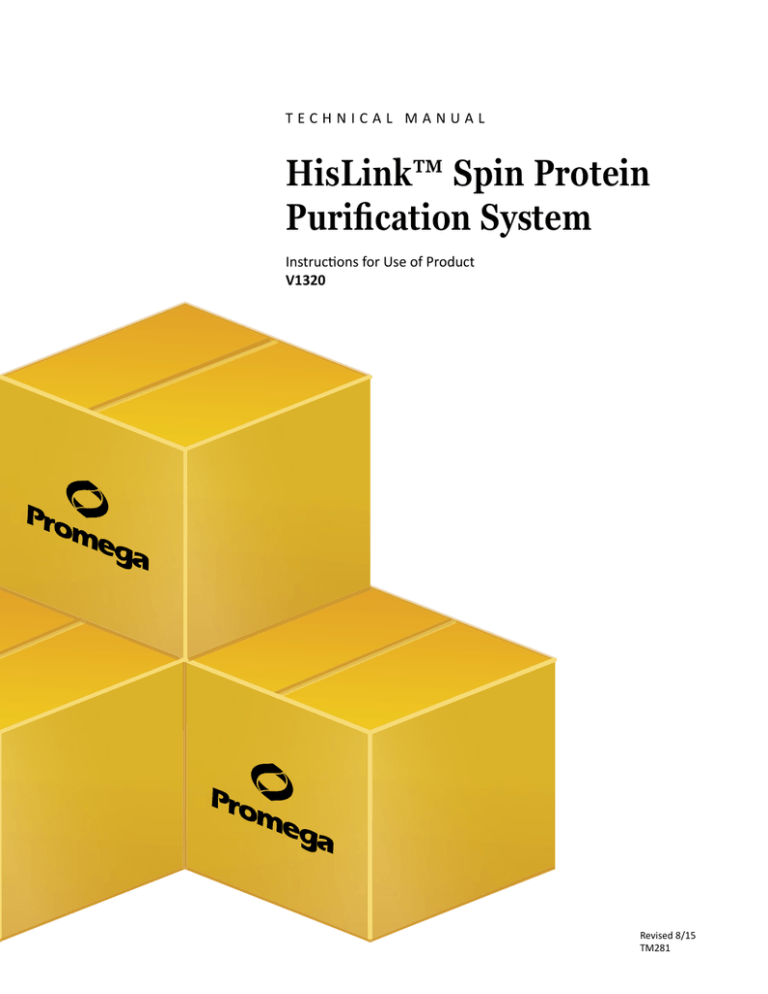
TECHNICAL MANUAL
HisLink™ Spin Protein
Purification System
Instructions for Use of Product
V1320
Revised 8/15
TM281
HisLink™ Spin Protein
Purification System
All technical literature is available at: www.promega.com/protocols/
Visit the web site to verify that you are using the most current version of this Technical Manual.
E-mail Promega Technical Services if you have questions on use of this system: techserv@promega.com
1. Description.......................................................................................................................................... 2
2. Product Components and Storage Conditions......................................................................................... 4
3. Polyhistidine- or HQ-Tagged Protein Purification Protocols.................................................................... 4
3.A. Preparation of Cell Cultures......................................................................................................... 5
3.B. Considerations When Adding Lysozyme........................................................................................ 5
3.C. Considerations When Using HQ-Tagged Proteins........................................................................... 5
3.D. Preparation of FastBreak™ Reagent/DNase I Solution................................................................... 5
3.E. Centrifugation Protocol ............................................................................................................... 6
3.F. Vacuum Protocol......................................................................................................................... 8
4. General Considerations........................................................................................................................ 9
4.A.Elution....................................................................................................................................... 9
4.B. Denaturing Conditions................................................................................................................. 9
4.C. Reuse of the Resin....................................................................................................................... 9
4.D. Adjuncts for Lysis or Purification................................................................................................ 10
5. Troubleshooting................................................................................................................................ 10
6. Appendix........................................................................................................................................... 12
6.A. Composition of Buffers and Solutions.......................................................................................... 12
6.B.Reference.................................................................................................................................. 12
6.C. Related Products....................................................................................................................... 12
7. Summary of Changes.......................................................................................................................... 13
Promega Corporation · 2800 Woods Hollow Road · Madison, WI 53711-5399 USA · Toll Free in USA 800-356-9526 · 608-274-4330 · Fax 608-277-2516
www.promega.com TM281 · Revised 8/15
1
1.Description
The HisLink™ Spin Protein Purification System(a,b,c) provides a simple, quick and robust method for purifying
polyhistidine- or HQ-tagged expressed proteins from a 700µl sample of E. coli cell culture, using either a centrifugeor vacuum-based method.
HQ (HisGln) tags developed by Promega perform in a manner similar to polyhistidine tags and are available as
N- or C-terminal fusion tags in the HQ-tagged Flexi® Vectors. See Section 6.C for details on these vectors.
Protein can be purified directly from culture medium containing bacterial cells expressing a polyhistidine- or
HQ-tagged protein. The bacterial cells are lysed using FastBreak™ Cell Lysis Reagent, followed immediately by
addition of HisLink™ Protein Purification Resin to the culture. Addition of these reagents results in simultaneous
bacterial lysis and binding of the polyhistidine- or HQ-tagged proteins. The samples are then transferred to a Spin
Column where unbound protein is washed away and the target protein is recovered by elution. This system requires the
use of a tabletop centrifuge or vacuum manifold (Figure 1). A schematic diagram of protein purification using the
HisLink™ Spin System is shown in Figure 2.
Advantages of the HisLink™ Spin Protein Purification System include:
•
Simple: No cell culture preparation steps.
•
Quick: No lengthy lysozyme incubations required to lyse cells.
•
Efficient: Binding capacity of 1mg of polyhistidine-tagged protein per spin column.
Figure 1. The Vac-Man® Laboratory Vacuum Manifold (Cat.# A7231).
2
Promega Corporation · 2800 Woods Hollow Road · Madison, WI 53711-5399 USA · Toll Free in USA 800-356-9526 · 608-274-4330 · Fax 608-277-2516
TM281 · Revised 8/15
www.promega.com
Lyse cells and
bind protein to
the resin.
Transfer contents to
Spin Column in a
Collection Tube or
Vacuum Adapter.
Spin Column
Spin Column
Vacuum
Adapter
Collection Tube
Centrifuge or apply
vacuum for 5 seconds.
Add HisLink™ Binding/Wash Buffer.
Centrifuge or apply
vacuum for 5 seconds.
Repeat wash steps.
Centrifuge 1 minute.
5583MA
Place Spin Column into a
new 1.5ml microcentrifuge
tube. Add 200µl of HisLink™
Elution Buffer.
Figure 2. Schematic of polyhistidine- or HQ-tagged protein purification using the HisLink™ Spin Protein
Purification System.
Promega Corporation · 2800 Woods Hollow Road · Madison, WI 53711-5399 USA · Toll Free in USA 800-356-9526 · 608-274-4330 · Fax 608-277-2516
www.promega.com TM281 · Revised 8/15
3
2.
Product Components and Storage Conditions
PRODUCT
HisLink™ Spin Protein Purification System
S I Z E C A T. #
25 reactions
V1320
Each system contains sufficient reagents for 25 manual purifications from 700µl of bacterial culture.
Includes:
•
•
•
•
•
•
•
•
5ml FastBreak™ Cell Lysis Reagent, 10X
1 vial DNase I (lyophilized)
5ml HisLink™ Protein Purification Resin
50ml HisLink™ Binding/Wash Buffer
10ml HisLink™ Elution Buffer
25 Spin Columns
25 Collection Tubes
1Protocol
Storage Conditions: Store the HisLink™ Spin Protein Purification System reagents at 4°C. Store the Spin Columns,
Collection Tubes and FastBreak™ Cell Lysis Reagent at room temperature (22–25°C). After reconstitution, store the
DNase I in aliquots at –20°C. A precipitate may form in the FastBreak™ Cell Lysis Reagent at low temperatures. If a
precipitate forms, warm the reagent to room temperature before use. Do not freeze the HisLink™ Resin.
3.
Polyhistidine- or HQ-Tagged Protein Purification Protocols
Materials to Be Supplied by the User
(Solution compositions are provided in Section 6.A.)
•
Nuclease-Free Water (Cat.# P1195)
•rotor
•
wide-bore pipette tips (E&K Scientific Cat.# 3502 - R96S)
•
NaCl or 5M NaCl solution for use with HQ-tagged proteins
•
•
•
•
4
tabletop centrifuge
1.5ml microcentrifuge tubes
optional: vacuum manifold for single tubes if using the vacuum protocol in Section 3.F (i.e., Vac-Man®
Laboratory Vacuum Manifold, Cat.# A7231)
optional: Vacuum Adapters (Cat.# A1331; for use with Vac-Man® Vacuum Manifold)
Promega Corporation · 2800 Woods Hollow Road · Madison, WI 53711-5399 USA · Toll Free in USA 800-356-9526 · 608-274-4330 · Fax 608-277-2516
TM281 · Revised 8/15
www.promega.com
3.A. Preparation of Cell Cultures
Bacterial cultures can be grown in tubes or flasks. Grow the bacterial cells containing a vector encoding the appropriate
polyhistidine- or HQ-tagged fusion protein to an O.D.600 of 0.4–0.6, then induce protein expression. For IPTG
induction, add IPTG to a final concentration of 1mM and incubate at 37°C for 3 hours or at 25°C overnight. Induction
time and IPTG concentration may require optimization. Cultures with concentrations of up to 8.0 O.D.600 units/ml have
been successfully used with the HisLink™ Spin Protein Purification System. Centrifugation or freezing of cells is not
required with this system. A maximum of 700µl of bacterial culture can be loaded per Spin Column.
3.B. Considerations When Adding Lysozyme
The HisLink™ Spin Protein Purification System is designed to lyse cells without the addition of lysozyme. Lysozyme, if
added, will copurify with the polyhistidine- or HQ-tagged protein unless 500mM NaCl is added to the Binding/Wash
Buffer.
3.C. Considerations When Using HQ-Tagged Proteins
HQ-tagged protein binding is optimized in the presence of NaCl; a maximum of 200mM NaCl final concentration is
recommended. Higher NaCl concentrations during binding can cause clumping of the HisLink™ Resin. If NaCl is
added to the HisLink™ Binding/Wash Buffer, we recommend its use in both binding and washing steps.
Purification of HQ-tagged proteins may be more efficient from a pelleted culture. Compare direct purification from
culture to purification from pelleted cells to verify which is more efficient for the target HQ clone.
To pellet cells, centrifuge at 8,000rpm for 2 minutes, then resuspend in 700µl of 100mM HEPES and follow the
standard protocol (Section 3.D, followed by Section 3.E or 3.F). For optimal HQ-tagged protein binding, add a
maximum of 200mM NaCl to the 100mM HEPES.
3.D. Preparation of FastBreak™ Reagent/DNase I Solution
1.
To prepare the FastBreak™/DNase I solution, add 80µl of Nuclease-Free Water to the vial of DNase I.
2.
Mix completely to dissolve the powder.
3.
Remove the DNase solution from the vial and add it to 1ml of Nuclease-Free Water. Mix well.
Note: Once resuspended, the DNase I solution can be stored at –20°C for 6 months and is stable for 8 freezethaw cycles.
Promega Corporation · 2800 Woods Hollow Road · Madison, WI 53711-5399 USA · Toll Free in USA 800-356-9526 · 608-274-4330 · Fax 608-277-2516
www.promega.com TM281 · Revised 8/15
5
3.D. Preparation of FastBreak™ Reagent/DNase I Solution (continued)
4.
Prepare the FastBreak™ Reagent/DNase I solution using the reagent quantities suggested in Table 1.
Note: Once prepared, the FastBreak™ Reagent/DNase I solution can be stored at –20°C for 6 months and is
stable for up to 5 freeze-thaw cycles.
Table 1. Reagent Volumes for Preparing the FastBreak™ Reagent/DNase I Solution.
# of Reactions
DNase I Solution
FastBreak™ Reagent, 10X
1
5.8µl
64.2µl
2
11.6µl
128.4µl
4
23.2µl
256.8µl
8
46.4µl
513.6µl
16
93µl
1,027µl
3.E. Centrifugation Protocol
1.
Pipet 700µl of bacterial culture into a 1.5ml microcentrifuge tube. Add 70µl of the FastBreak™ Reagent/DNase I
solution prepared in Section 3.D, Table 1, to the culture.
Note: For HQ-tagged proteins, please see Section 3.C.
2.
Resuspend the resin and allow it to settle. Once the resin has settled, use a wide-bore pipette tip to transfer
75µl of the HisLink™ Resin from the settled resin bed to the 1.5ml microcentrifuge tube. To successfully transfer
resin, place the wide-bore pipette tip deep into the resin and pipet slowly to assure that a consistent amount of
resin is drawn into the pipette. Allow the resin to resettle between each pipetting.
Note: We recommend optimizing the amount of HisLink™ Resin used for low- (<1mg/ml) or
high- (>1mg/sample) expressing proteins. For low-expressing proteins, less resin should be used; similarly,
for high-expressing proteins, more resin per sample can be used.
3.
Incubate the sample and resin for 30 minutes, mixing frequently on a rotating platform or shaker to optimize
binding.
6
Promega Corporation · 2800 Woods Hollow Road · Madison, WI 53711-5399 USA · Toll Free in USA 800-356-9526 · 608-274-4330 · Fax 608-277-2516
TM281 · Revised 8/15
www.promega.com
4.
Place a Spin Column onto a Collection Tube (or a new 1.5ml microcentrifuge tube). Use a wide-bore pipette tip
to transfer the lysate and resin from the original 1.5ml microcentrifuge tube in Step 3 to the spin column. If resin
remains in the 1.5ml microcentrifuge tube, add HisLink™ Binding/Wash Buffer to the tube, then transfer the
buffer and remaining resin to the spin column.
5.
Centrifuge the spin column with the collection tube for 5 seconds or until the liquid clears the spin column.
6.
To save the flowthrough, remove the spin column from the collection tube and transfer the flowthrough from the
collection tube to a new 1.5ml microcentrifuge tube. Otherwise, discard the flowthrough.
7.
Place the spin column back onto the collection tube. Add 500µl of HisLink™ Binding/Wash Buffer to the spin
column, then cap the spin column. Centrifuge for 5 seconds or until the Binding/Wash Buffer clears the spin
column. Discard the flowthrough. Repeat for a total of two washes.
8.
Take the spin column off the collection tube and wipe the base of the spin column with a clean absorbent paper
towel to remove any excess HisLink™ Binding/Wash Buffer.
9.
Place the spin column onto a new 1.5ml microcentrifuge tube. Add 200µl of HisLink™ Elution Buffer. Cap the
spin column and tap or flick it several times to resuspend the resin. Wait 3 minutes.
Note: HQ-tagged proteins may elute with a lower concentration of imidazole (50–100mM) compared to
polyhistidine-tagged proteins. Section 4.A has details on the use of imidazole for elution.
10. Centrifuge the spin column and microcentrifuge tube at 14,000rpm for 1 minute to collect the eluted protein.
Promega Corporation · 2800 Woods Hollow Road · Madison, WI 53711-5399 USA · Toll Free in USA 800-356-9526 · 608-274-4330 · Fax 608-277-2516
www.promega.com TM281 · Revised 8/15
7
3.F. Vacuum Protocol
1.
Pipet 700µl of bacterial culture into the Collection Tube or a 1.5ml microcentrifuge tube. Add 70µl of the
FastBreak™ Reagent/DNase I solution prepared in Section 3.D, Table 1, to the bacterial culture.
Note: For HQ-tagged proteins, please see Section 3.C.
2.
Resuspend the resin and allow it to settle. Once the resin has settled, use a wide-bore pipette tip to transfer
75µl of the HisLink™ Resin from the settled resin bed to the tube containing the culture. To successfully transfer
resin, place the wide-bore pipette tip deep into the resin and pipet slowly to ensure that a consistent amount of
resin is drawn into the pipette. Allow the resin to resettle between each pipetting.
Note: We recommend optimizing the amount of HisLink™ Resin used for low- (<1mg/ml) or
high- (>1mg/sample) expressing proteins. For low-expressing proteins, less resin should be used; similarly,
for high-expressing proteins, more resin per sample should be used.
3.
Incubate the sample and resin for 30 minutes, mixing frequently on a rotating platform or shaker to optimize
binding.
4.
Place a spin column onto a Vacuum Adapter (Cat.# A1331), then attach the adapter to a vacuum port. Use a
wide-bore pipette tip to transfer the lysate and resin from Step 3 to the spin column. If resin remains in the
1.5ml microcentrifuge tube, add HisLink™ Binding/Wash Buffer then transfer the remaining resin to the spin
column.
!
Any unused ports on the vacuum manifold must be closed for the manifold to work properly.
5.
Apply a vacuum for 5 seconds or until the lysate clears the spin column.
6.
Add 500µl of HisLink™ Binding/Wash Buffer to the spin column. Apply a vacuum for 5 seconds. Repeat for a
total of two washes.
7.
Take the spin column off the vacuum adapter and wipe the base of the spin column with a clean absorbent paper
towel to remove any excess HisLink™ Binding/Wash Buffer.
8.
Place the spin column onto a new 1.5ml microcentrifuge tube. Add 200µl of HisLink™ Elution Buffer. Cap the
spin column and tap or flick it several times to resuspend the resin. Wait 3 minutes.
Note: HQ-tagged proteins may elute with a lower concentration of imidazole (50–100mM) compared to
polyhistidine-tagged proteins.
9.
Centrifuge the spin column with the 1.5ml microcentrifuge tube at 14,000rpm for 1 minute to collect the eluted
protein.
8
Promega Corporation · 2800 Woods Hollow Road · Madison, WI 53711-5399 USA · Toll Free in USA 800-356-9526 · 608-274-4330 · Fax 608-277-2516
TM281 · Revised 8/15
www.promega.com
4.
General Considerations
4.A.Elution
Imidazole (50–1,000mM): For certain proteins and purification tags, elution efficiency may need to be optimized.
Polyhistidine-tagged proteins can be eluted using 250–1,000mM imidazole. Polyhistidine-tagged proteins containing
less than six histidines typically require less imidazole for elution, while such proteins containing more than six
histidines may require higher levels of imidazole. The HQ tag contains three histidines and three glutamines
(HQHQHQ) and may be eluted with a lower concentration of imidazole (50–100mM).
EDTA (>100mM): Strong chelators such as EDTA will strip nickel from the resin and release bound protein. EDTA is
generally not as efficient as imidazole for elution, and it has the added complication that Ni(EDTA) will be present in
the eluate and must be removed.
Acidic pH: Polyhistidine binding to immobilized nickel is most efficient at a pH well above the pKa of polyhistidine
(~ 6.0). Above pH 7, more than 90% of the imidazole moieties of histidine will be deprotonated and available to bind
to nickel (1). Lowering the pH of a binding reaction below the pKa of histidine leads to protonation of the polyhistidine
tag and release from the resin. Buffers that can be used at this low pH for elution include citrate and acetate (pH 3–5).
Trifluoroacetic acid (e.g., 0.1% TFA) can also be used for elution, and because of its volatility, it is directly compatible
with mass spectrometry analysis. As with EDTA elution, acidic elution is generally not as efficient as imidazole elution
and can result in leaching of nickel, which may become quite significant at pH values below 4. These considerations
also apply to HQ-tagged proteins.
4.B. Denaturing Conditions
Proteins that are expressed as inclusion bodies or insoluble fractions should be solubilized with chaotropic agents such
as guanidine-HCl or urea before purification. Solubilized proteins can be purified by modifying the above protocols to
include the appropriate amount of denaturant (up to 6M guanidine-HCl or up to 8M urea) during binding.
4.C. Reuse of the Resin
Due to the drying of the particles during the elution step, we do not recommend reuse of the particles.
Promega Corporation · 2800 Woods Hollow Road · Madison, WI 53711-5399 USA · Toll Free in USA 800-356-9526 · 608-274-4330 · Fax 608-277-2516
www.promega.com TM281 · Revised 8/15
9
4.D. Adjuncts for Lysis or Purification
We have found that the following materials may be used without adversely affecting the ability of HisLink™ Protein
Purification Resin to bind and elute polyhistidine- or HQ-tagged proteins.
Table 2. Reagents Compatible with the HisLink™ Spin Protein Purification System.
Additive
Concentration
HEPES, Tris or sodium phosphate buffers
≤100mM
®
Triton X-100
≤2%
Tween®
≤2%
glycerol
≤20%
guanidine-HCl
≤6M
urea
≤8M
RQ1 RNase-Free DNase
≤5µl/1ml original culture
5.Troubleshooting
For questions not addressed here, please contact your local Promega Branch Office or Distributor. Contact information
available at: www.promega.com. E-mail: techserv@promega.com
Symptoms
Possible Causes and Comments
Low amounts of or no protein recovered
Protein expression not induced. Check concentration and stability of
inducer (e.g., IPTG).
Expressed protein may not be stable. Add protease inhibitors to the lysis
step. If the protein is degraded at the time of expression, reduce the
induction period. Also try using a lower temperature during induction
(16–20°C).
Protein may be expressed in low amounts. Try different temperatures
during induction. Check by Western blotting if using polyhistidine tag.
Confirm that the sequence of the clone is correct.
Protein may be misfolded or expressed in inclusion bodies. Check the
lysate, pellet or flowthrough for the presence of insoluble protein of
interest.
10
Promega Corporation · 2800 Woods Hollow Road · Madison, WI 53711-5399 USA · Toll Free in USA 800-356-9526 · 608-274-4330 · Fax 608-277-2516
TM281 · Revised 8/15
www.promega.com
5.
Troubleshooting (continued)
Symptoms
Possible Causes and Comments
Low amounts of or no protein recovered
(continued)
Cells not lysing properly. Be sure to use the recommended volume of
FastBreak™ Cell Lysis Reagent, 10X.
Particles and lysate are not well mixed. Mix frequently for 30 minutes.
Protein may have metal binding domain. Try eluting with a higher
concentration of imidazole or with acidic conditions such as citrate.
Polyhistidine- or HQ-tagged protein may purify more efficiently from
pelleted cells. Centrifuge cells 2 minutes at 8,000rpm, discard
supernatant and resuspend pellet in 700µl of 100mM HEPES, then
follow protocol in Sections 3.D and 3.E or 3.F. To optimize HQ-tagged
protein binding, add a maximum of 200mM NaCl to the 100mM
HEPES.
Co-elution of contaminating proteins
There may be an interacting protein in the cell. Add 0.5–1M NaCl
(final concentration) to the Binding/Wash Buffer.
Add protease inhibitors to the FastBreak™ Reagent/DNase I solution,
Binding/Wash and Elution Buffers to prevent possible protein
degradation.
Lysate not clearing the Spin Column
Incorrect amount of DNase I may have been added. Check that the
DNase I was diluted properly (Section 3.D).
DNase I no longer active. Try using a new aliquot of DNase I. Store
resuspended DNase I in aliquots at –20°C.
Culture O.D.600 exceeds system recommendations (≤8 O.D.600). Adjust
the cell concentration or add more DNase I.
Unused vacuum manifold ports were not closed. Close all unused ports
to ensure vacuum efficiency.
Wash solution not clearing
Poor vacuum efficiency. Check vacuum connection to the manifold to be
sure that the hoses are connected properly.
Unused manifold ports were not closed. Seal all unused ports to ensure
good vacuum efficiency.
Resin clumping due to inactive DNase I or high salt content. Pipet to
break up clumps, then repeat wash steps.
Promega Corporation · 2800 Woods Hollow Road · Madison, WI 53711-5399 USA · Toll Free in USA 800-356-9526 · 608-274-4330 · Fax 608-277-2516
www.promega.com TM281 · Revised 8/15
11
6.Appendix
6.A. Composition of Buffers and Solutions
HisLink™ Binding/Wash Buffer (pH 7.5)
100mMHEPES
10mMimidazole
HisLink™ Elution Buffer (pH 7.5)
100mMHEPES
500mMimidazole
6.B.Reference
1.
Hochuli, E. (1990) Purification of recombinant proteins with metal chelate adsorbent. Genet. Engineer. News
12, 87–98.
6.C. Related Products
Size
Cat. #
Vac-Man® Laboratory Vacuum Manifold
Product
1 each
A7231
HisLink™ 96 Protein Purification System
1 × 96
V3680
5 × 96 V3681
50ml
V8821
HisLink™ Protein Purification Resin
MagneHis™ Protein Purification System
MagZ™ Protein Purification System
MagneGST™ Protein Purification System
Broad Range Protein Molecular Weight Markers Gel Drying Kit, 17.5 × 20 cm capacity
12
5mlV8823
65 reactions
V8500
325 reactions
V8550
30 purifications
V8830
40 reactions
V8600
200 reactions
V8603
100 lanes
V8491
1 kit
V7120
Promega Corporation · 2800 Woods Hollow Road · Madison, WI 53711-5399 USA · Toll Free in USA 800-356-9526 · 608-274-4330 · Fax 608-277-2516
TM281 · Revised 8/15
www.promega.com
HQ Tag Flexi® Vectors
Product
SizeCat.#
pFN6A (HQ) Flexi® Vector
20µg
C8511
pFN6K (HQ) Flexi Vector
20µg
C8521
pFC7A (HQ) Flexi® Vector
20µg
C8531
pFC7K (HQ) Flexi Vector
20µg
C8541
®
®
pFN6A and pFN6K (HQ) Flexi® Vectors: These vectors are designed for expressing N-terminal, HisGln (HQ)
metal-binding peptide fusion proteins in bacteria and in vitro protein expression systems. The vectors are configured to
append the peptide sequence MKHQHQHQAIA to the amino terminus of a protein. The vectors are designed for
bacterial or in vitro protein expression via the T7 RNA polymerase promoter and are available with ampicillin [pFN6A
(HQ) Flexi® Vector] or kanamycin [pFN6K (HQ) Flexi® Vector] resistance for selection in E. coli.
pFC7A and pFC7K (HQ) Flexi® Vectors: These vectors are designed for expressing C-terminal, HisGln (HQ)
metal-binding peptide fusion proteins in bacteria and in vitro protein expression systems. The vectors are configured to
append the peptide sequence VSHQHQHQ to the carboxy terminus of a protein. The vectors are designed for bacterial
or in vitro protein expression via the T7 RNA polymerase promoter and are available with ampicillin [pFC7A (HQ)
Flexi® Vector] or kanamycin [pFC7K (HQ) Flexi® Vector] resistance for selection in E. coli.
For further information regarding these HQ Flexi® Vectors and the Flexi® Cloning Systems, refer to the Flexi® Vector
System Technical Manual #TM254 or visit: www.promega.com
7.
Summary of Changes
The following change was made to the 8/15 revision of this document:
1.
The document design was updated.
Promega Corporation · 2800 Woods Hollow Road · Madison, WI 53711-5399 USA · Toll Free in USA 800-356-9526 · 608-274-4330 · Fax 608-277-2516
www.promega.com TM281 · Revised 8/15
13
(a)
Certain applications of this product may be covered by patents issued to parties other than Promega and applicable in certain countries. Because
purchase of this product does not include a license to perform any of these patented applications, users of this product may be required to obtain a
patent license depending upon the particular application and country in which the product is used.
(b)
(c)
This product is licensed for use under U.S. Pat. No. 6,174,704.
U.S. Pat. Nos. 7,112,552 and 7,354,750.
© 2006–2015 Promega Corporation. All Rights Reserved.
Flexi and Vac-Man are registered trademarks of Promega Corporation. FastBreak, HisLink, HaloTag, MagneGST, MagneHis and MagZ are trademarks of
Promega Corporation.
Triton is a registered trademark of Union Carbide Chemicals & Plastics Technology Corporation. Tween is a registered trademark of ICI Americas, Inc.
Products may be covered by pending or issued patents or may have certain limitations. Please visit our Web site for more information.
All prices and specifications are subject to change without prior notice.
Product claims are subject to change. Please contact Promega Technical Services or access the Promega online catalog for the most up-to-date
information on Promega products.
14
Promega Corporation · 2800 Woods Hollow Road · Madison, WI 53711-5399 USA · Toll Free in USA 800-356-9526 · 608-274-4330 · Fax 608-277-2516
TM281 · Revised 8/15
www.promega.com

